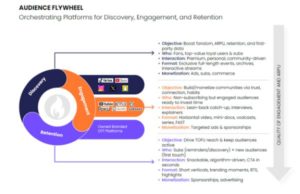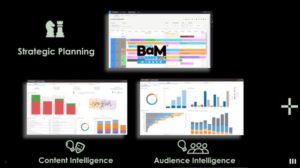
Chris Pulis
CTO, Globecast Americas
Cloud playout is not a new idea; it’s been discussed in our industry for at least a decade, including early attempts at creating and supplying solutions. But it’s only more recently that it has become a reality and it’s certainly an important part of the future. Globecast is leading the way.
What do we mean by cloud playout? We mean software playout deployed in the cloud: a virtualized playout system. At Globecast it can also mean the media supply chain, playout and distribution are all in the cloud, but we likely have to provide a playout solution that services numerous distribution methods and destinations, using both traditional and new models.
At Globecast, we have developed playout platforms that are entirely cloud based. As an example, we’ve been working with one of the largest, most, complex US cable network customers and we’re now fully supporting their playout (more news of this soon). We are very confident we can support the needs of broadcasters of all shapes and sizes, right up to the most demanding. Our customers quickly see the benefits of cloud playout.
The challenges for someone whose infrastructure is on premise is the inevitable technology refresh on a three-to-five-year cycle. Hardware does wear out; it can also become antiquated in terms of performance needs and in terms of additional delivery channels being added. Using cloud playout, nobody writes a check for new hardware and we’re able to keep customers using the most relevant, up-to-date technologies. For example, as new graphics cards are released and new graphics capabilities in the cloud are launched, we can pass along these advantages to customers who may want to increase the level of complexity of their on-air product by using multi-layer graphics. We simply need to turn them on.
If it’s virtualized, what we’re also able to do using infrastructure as code techniques -aka DevOps (more on that shortly) - we can migrate any existing cloud playout operation in a short period of time to the latest infrastructure with very little problem and it’s seamless to the customer. That’s how we can control costs and create opportunities. Time-to-market is significantly reduced too, of course.

When it comes to provisioning new services, once you have it all set up in the cloud, we can spin things up and down in orders of magnitude faster using an OPEX model. In many cases, customers are also only paying for the capacity they use and as a result works this better on their balance sheets.
Graphics have been a challenge since the dawn of cloud playout but this is also a hurdle we have been able to overcome. Graphics need a graphics engine, even in a software environment, to playout multi-layered compositions. This has to be done using a high-end GPU-based processing engine and this is part of the AWS infrastructure that we use. The level of complexity required determines the exact nature of the software that we deploy, tailored to each customer. There’s isn’t a channel on air that we can’t handle, not only in HD but UHD, too.
We work with partner vendors and service suppliers across this space and we have the infrastructure available, courtesy of our cloud infrastructure partnerships, to comprehensively test these solutions. We provide clear feedback, giving suppliers the opportunity to make any adaptations to suit our overall architecture. We have a comprehensive toolkit and we use whichever tools are most appropriate.
In terms of media processing, again this varies on a per-customer basis. As an example, with a major customer of ours, they have mastered content that they own, along with graphics, promos and commercials. All of this is stored in the cloud. We then use automation, with their schedule, to pull the necessary files into the processing pipeline that transcodes the content, sometimes including audio channel re-mapping, and then it’s staged for playout. It’s fully automated.
Our Orchestrator solution – a cloud MAM built in-house - is the glue between the customer’s schedule and the playout automation systems. It pairs the schedule that the customer creates from their traffic system with the media, then it moves that media and stages it for processing by the processing pipeline for playback. So media can be in an Amazon S3 bucket, for example, or it can even be in Glacier, which is the equivalent of an LTO tape in the cloud – or another high-performance storage tier - and Orchestrator keeps track of it. We’re not only talking about programming; we’re talking about commercials, graphics, snipes, ratings, icons, everything. The system is able to intelligently identify media conflicts in the schedule. If there’s a piece of media that’s missing, it escalates that to both the customer and our operations team, if necessary. Orchestrator also manages the media storage life cycle. When programs have played, if they’re not scheduled again quickly, they don’t stay sitting on the playout storage, filling it up, they’re deleted and then they’ll be brought back on when the time comes. This, again, keeps costs, like storage, down, both for Globecast and our customers.
Infrastructure as Code (IaC) is the process of creating and managing cloud-based technologies using scripts – hence code – to do so. The script is then “read”, or accepted, by systems like AWS’ CloudFormation or the cloud-agnostic solution Terraform. The systems created using IaC can be as simple or as complex as required, i.e. entirely cloud-based complex playout infrastructure can be generated far faster and cost-effectively via this method. Changes to a service can be made very quickly and services can be duplicated in a very short time, usually a matter of minutes. We see DevOps and IaC as an integral part of our industry going forward and it’s something that’s increasingly important across what we do.
Cloud playout is a paradigm shift. There are customers that know they are ready to make the change, but even among those, many are still apprehensive. It’s vital for us to understand that dynamic and bring them along on the journey in order to help make that leap into a “new normal”. We help them understand how systems are virtualized in the cloud and how the process flow is different from on premise. One point that’s very important to make customers understand is all of the principles of redundancy still apply. Failover is central to the design of our cloud architectures, but we have to acquaint them with how this works in this new context.
Another key point is that we work with customers on how their content flows into the cloud environment and what opportunities there are for migrating their current processes as part of a cloud deployment. At Globecast what we can do, and what we recommend, is virtualize the customer’s content supply chain upstream from playout so that automation is driving much more of the ingest and content prep process that’s common in traditional, on-prem environments.
Cloud playout is the future, but as with all Globecast solutions, this is not a one-size-fits-all situation – far from it. We have developed strong partnerships alongside our market-leading experience to make cloud playout the reality it should be so our customers can realize the numerous, long-lasting benefits.









